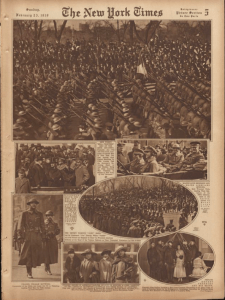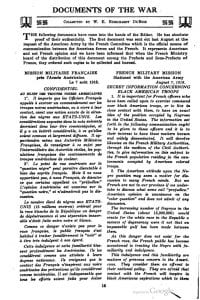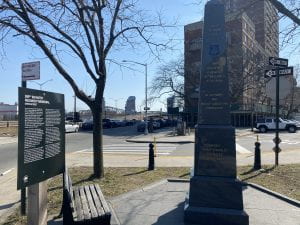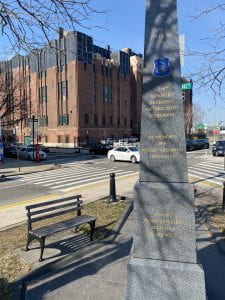In spring 2021, students in English 309 studied the history and literature of World War I. A few students elected to fulfill Stony Brook’s experiential learning requirement (EXP+) by visiting, researching, and writing about a WWI memorial on Long Island or in NYC. In the second of these posts, English major Joshua Balan writes about a Harlem memorial.
On the intersection of 142nd Street and 5th Avenue in Harlem, New York, the 369th Regiment Armory Memorial is a piercing reminder of the importance of black contributions to World War I, and its reverberate effects on the neighborhood. In a world as rich and storied as Harlem is, this memorial captures the spirit of war heroes who struggled to shift their narrative from one coast of the Atlantic to the other, from setbacks at home to those abroad. These men were not properly defended, they were not given guns nor training, and they were not deemed heroes. They were America’s donation to the French army (Daley), denied even a farewell parade because “Black is not a color of the rainbow” (Ray). Without the bestowal of honor or respect back at home, the Harlem Hellfighters of the 369th Armory had to solidify their reputation through sheer determination and force (Durr). This memorial commemorates the bravest heroes of the Great War and it continues to celebrate their spirit in Harlem.
W. E. B. DuBois perhaps said it best in 1919 when he stated, “The American Negro soldier in France was treated with the same contempt and undemocratic spirit as the American Negro is treated in the U.S.” (Maloney). This was in 1919, shortly after the windfall of recognition was finally beginning to settle back in the States. With their accomplishments in Europe, the “Harlem Hellfighters,” as they were christened by German adversaries, finally received the praise they were due after they sacrificed countless lives in the war (Cohen). Along with a massive 5th Avenue parade that attracted thousands of New York residents, newspapers from all over the country sang their praise, eager to herald an unheralded narrative (Fife). They achieved worldwide fame from participants on both sides.

The New York Times (February 23, 1919) celebrates the contributions of both white and black soldiers https://www.loc.gov/resource/sn78004456/1919-02-23/ed-1/?sp=1&r=-1.16,-0.074,3.32,1.486,0
The New York Times remarked at the unit’s essential contributions to Allied victory. Along with their sister all-black regiments, the 370th-372th Regiments (Maloney), these men were admired everywhere for leading the way through several advancements, including the Meusse-Argonne Offensive, where they retook the German Rhine River ahead of their allies and foes alike (Durr). With heroes such as Henry Johnson and Needham Roberts receiving the French Croix de Guerre medal, they were instant rockstars in Europe. But nonetheless, their legacy was threatened by the only country who didn’t see these soldiers for who they were: the United States of America.
The Harlem Hellfighters went overseas because front-line warfare sees no skin color. In America, white soldiers couldn’t stand to work side by side with them, so American Expeditionary Force commander John J. Pershing killed two birds with one stone by shipping them off to France, as the French army’s problem to deal with (Ziobro). The Harlem Hellfighters eagerly traded in their shovels back home in America—originally, they were restricted from serving in combat—for actual guns and uniforms from the French army’s 161th Division. All that the U.S. sent in regards to the Hellfighters was a memo warning French soldiers of the dangers posed by black soldiers, who were allegedly “rapists,” “thieves,” and threats to European women (Onion). But still, the 369th Regiment fought valiantly to distance themselves from America’s overseas dogmas, and this enabled a rewritten narrative throughout Europe.

A translated version of the racist American memo to the French army, warning them of the dangers posed by black men. This memo was reproduced by W. E. B DuBois in 1919.
Memorials are not new for the 369th Regiment, at least outside of the states. In fact, prior to the last twenty years, recognition for the 369th Regiment was seemingly a foreign affair, and it took over a hundred years for the U.S. to catch up. Take Privates Henry Johnson and Needham Roberts, for example, who fought off an entire German unit despite being severely outnumbered. In spite of being the first man, black or white, to receive France’s highest honor in the Croix de Guerre in 1918, Private Johnson only received the Presidential Medal of Freedom nearly a century after he was gone, in 2016 (Smithsonian). France holds most of the bodies of WWI’s Harlem Hellfighters, as its Meuse-Argonne Cemetery a holding ground rather than shipping the dead black men back to America (Cohen). Even the Hellfighter nickname is foreign, having been coined by German rivals way before it came to America. It was just last year, in September 2020, that the U.S. formally declared “Hellfighters” as the official designation of the 369th Regiment. In spite of all the pomp and circumstance going on elsewhere, the Hellfighters had to wait for the U.S. to recognize their contributions.
The first obelisk dedicated to the 369th Regiment was erected in Sechault, France, the village which the Hellfighters helped win back for France in September 1918, on its 99th anniversary (Cohen). This was nearly a decade before the U.S. replicated the 12”4’ monument in Harlem. Costing more than a hundred grand between the monument and the triangle redesign, this required a vast amount of effort and coordination, as much was made about the history of the moment. Surrounded by key contributors to the monument, former Parks and Recreation commissioner Adrian Benepe hailed it by saying, “Monuments are created to remember those whom we must never forget.” It was placed right across the street from the 369th Regiment Armory, which actively serves as a training facility to this day, to commemorate the 369th’s continual impact on the Harlem community. Finally, the soldiers were being honored with monuments here, just like they have long deserved.

The 369th Regiment Obelisk at 142nd Street and 5th Avenue in Harlem
The form of the monument is quite striking, and it holds plenty of history which is worth knowing . Obelisks date back to Ancient Egypt, as precursors of sorts to the famous pyramids we see today. They date back thousands of years, and through their mysterious structures, they served all kinds of commemoratory purposes that were eventually adapted by the Western world (Mark). The 369th Regiment obelisk is similar to the ancient Egyptian obelisks in that it holds significant meaning overseas just as it does in the U.S. “Cleopatra’s Needles,” as they were popularly referred to in the late 19th century, intrigued audiences all the way from New York to London, and the first U.S. obelisk arrived here following a months-long sea journey, by ship, in 1881 (Central Park Conservancy). Obelisks are cultural phenomenons, just like the people they commemorate. The Harlem Hellfighters’ obelisk is certainly no exception.
America is continuing to reckon with its late embrace of history, and our monuments are continual reminders of what the rest of the world can teach us. For far too long, The U.S. made special efforts towards erasing the memories of Harlem’s Hellfighters, and it is up to the community to make up for lost history. This work cannot be done overnight, because we are continuing to find new life through expanding upon our narratives. We can only continue to value new heroes and acts of valor today through learning valuable lessons from years past. From Egypt to Sechault to Harlem, it is clear that our monuments continue to expand our stories in marvelous ways. And now, we eagerly anticipate the next story these Hellfighters will dazzle us with in the future.

The Harlem Hellfighters finally remembered
Works Cited
- Cohen, Robert. “African-American Sacrifice in the Killing Fields of France.” New York Times: Feb. 2021, https://www.nytimes.com/2021/02/28/world/europe/france-world.
- Daley, Suzanne. “Four Who Fought With France in 369th Lauded in Harlem.” New York Times, May 1982, https://www.nytimes.com/1982/05/31/nyregion/four-who-fought-for- france-with-369th-lauded-in-harlem.html.
- Daly, Victor. Not Only War. University of Virginia Press, Charlottesville and London: 1932.
- Durr, Eric. “After 100 years the Harlem Hellfighters nickname is finally official.” New York National Guard, 1 Feb. 2021.
- Fife, Thomas William. “AFRICAN-AMERICANS IN THE GREAT WAR 1917-19.” Military Images, vol. 27, no. 4, 2006, pp. 4–46. JSTOR, www.jstor.org/stable/44034907.
- “First Life: The Obelisks in Egypt.” Wellesey College, http://omeka.wellesley.edu/piranesi-rome/exhibits/show/romanobelisks/obelisks-in-egypt.
- New York Times: Feb. 23, 1919, https://www.loc.gov/resource/sn78004456/1919-02-23/ed-1/?sp=1&r=-1.16,-0.074,3.32,1.486,0
- Maloney, Wendi. “World War I: African-American Soldiers Battle More Than Enemy Forces.” Library of Congress, Feb. 2018, https://blogs.loc.gov/loc/2018/02/world-war-i-african-american-soldiers-battle-more-than-enemy-forces/?loclr=blogser.
- Mark, Joshua. “Egyptian Obelisk.” World History, 6 Nov. 2016, https://www.worldhistory.org/Egyptian_Obelisk/.
- “Obelisk (Cleopatra’s Needle)”. Central Park Conservancy. https://www.centralparknyc.org/locations/obelisk.
- Onion, Rebecca. “A WWI-Era Memo Asking French Officers to Practice Jim Crow with American Troops.” Slate, 27 Apr, 2016, https://slate.com/human-interest/2016/04/secret-information-concerning-black-troops-a-warning-memo-sent-to-the-french-military-during-world-war-i.html.
- “Harlem Hellfighters Memorial Unveiled.” NYC Parks, No. 87, 29 Sep. 2006. https://www.nycgovparks.org/news/press-releases?id=19816.
- Ray, Michael. “Harlem Hellfighters”. Encyclopedia Britannica: 18 Apr. 2020, https:// www.britannica.com/topic/Harlem-Hellfighters.
- “Remembering the Harlem Hellfighters.” National Museum of African American History and Culture, Smithsonian. Retrieved from https://nmaahc.si.edu/blog-post/remembering-harlem-hellfighters
- Ziobro, Melissa. “369th Sustainment Brigade.” On Point, vol. 23, no. 2: 2017, pp. 23–26. JSTOR, www.jstor.org/stable/26478337.

There are many blogs on the Internet. But I can definitely say that your blog is amazing. It has all the qualities a perfect blog should have.
cookie clicker
it is very good topic
شركة مكافحة حشرات بالمدينة المنورة
Thanks for letting us know this important information.
coloring pages
최고의 메이져 먹튀검증 이곳에서 즐기세요
검증된 업체 먹튀검증 최고의 메이져
여기가바로 먹튀검증 배팅의성지